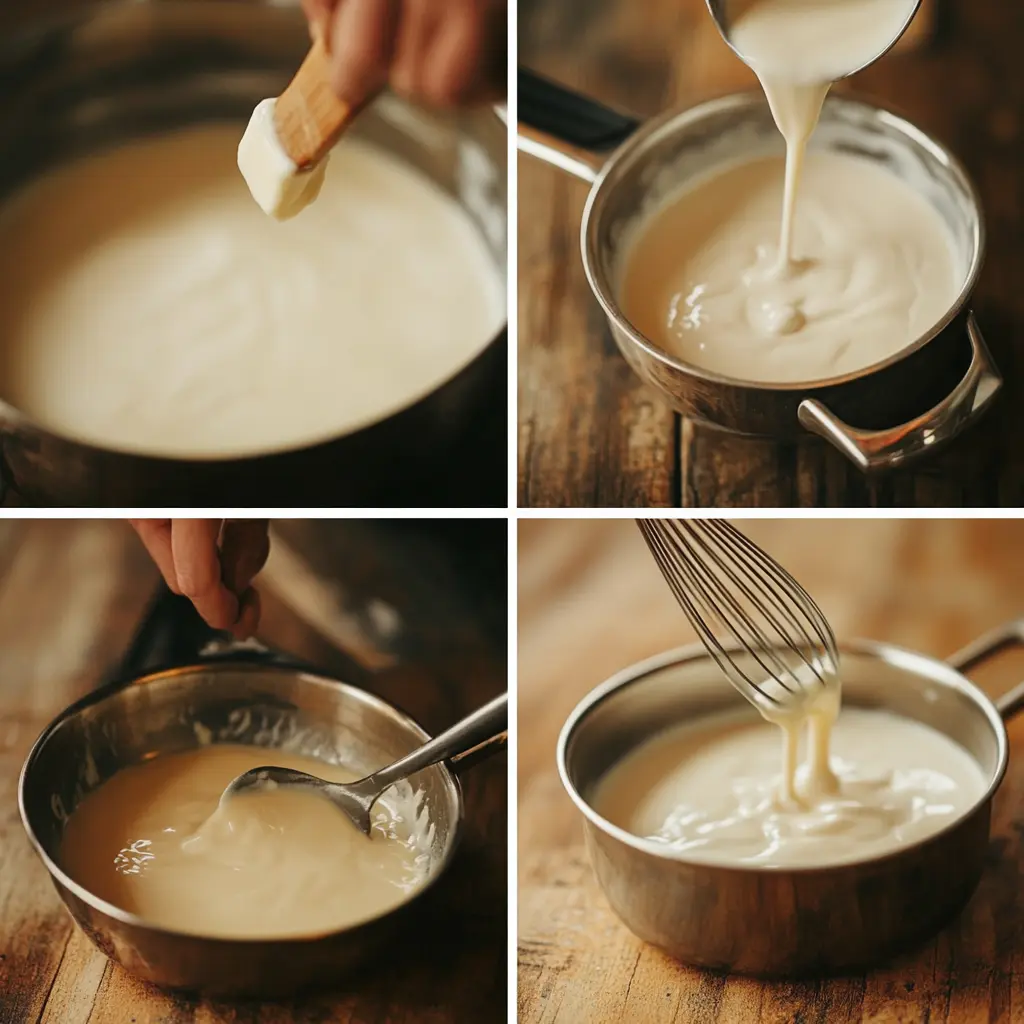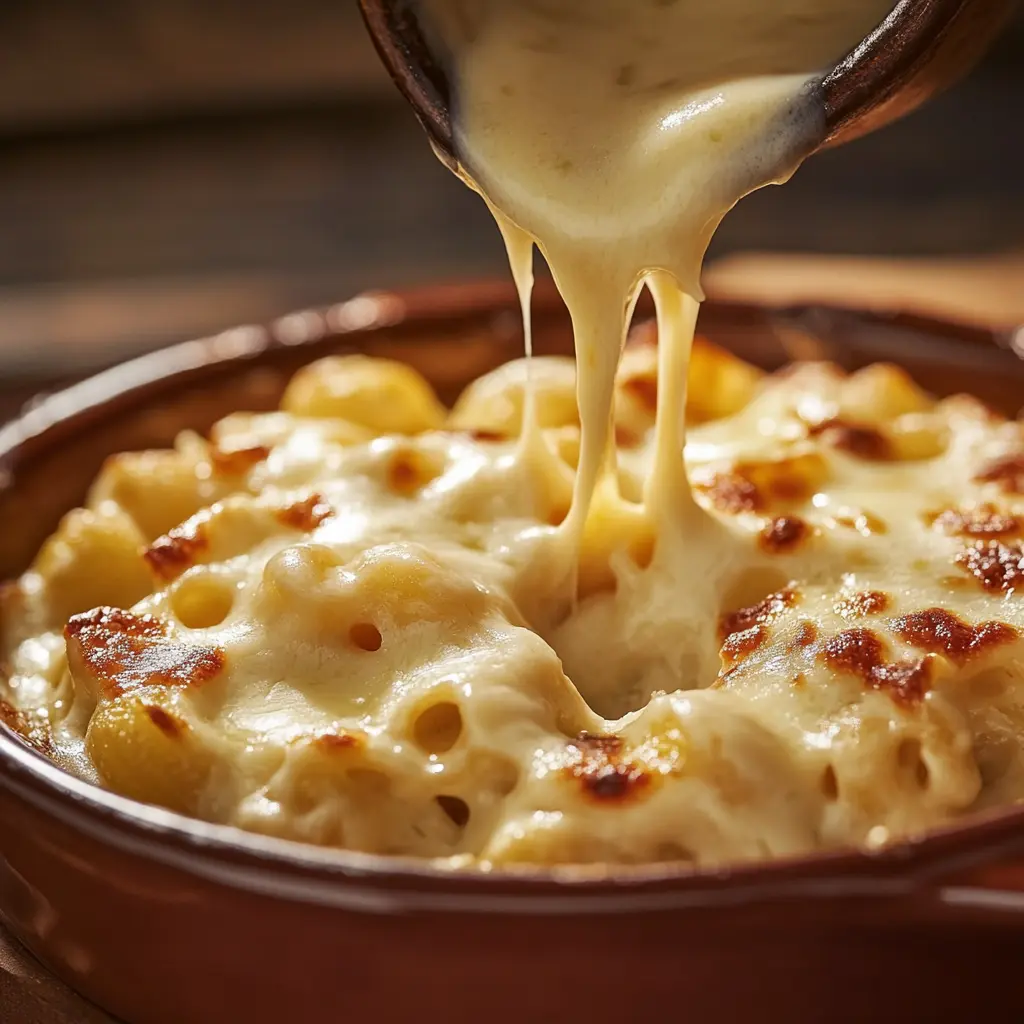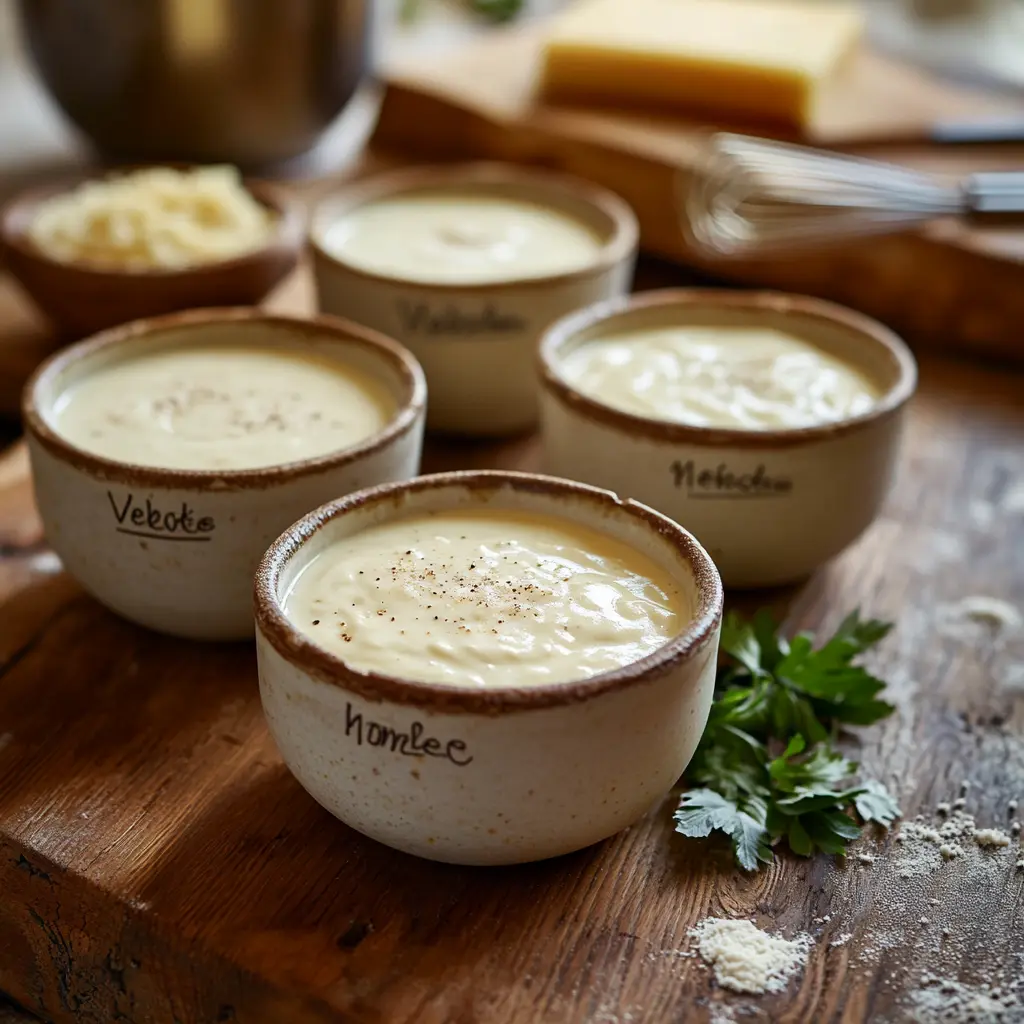White sauces are a cornerstone in cooking, beloved for their creamy texture and versatility in countless dishes. Rooted in classic European cuisine, particularly French cooking, white sauces bring richness, flavor, and elegance to both simple and gourmet recipes. These sauces are often roux-based, consisting of butter, flour, and milk or stock. But here’s the interesting part: not all white sauces are the same!
This article will explore the 3 main types of white sauces—Béchamel, Velouté, and Mornay. You’ll learn how to prepare each sauce, discover the subtle differences, and find practical tips to incorporate them into your culinary adventures. By the time you’re done reading, you’ll have a solid grasp of these sauces, their uses, and how to perfect them in your kitchen.
Part 1: Introduction to White Sauces
White sauces are often regarded as the backbone of European cuisine, particularly French cooking. They elevate dishes by adding depth, smooth texture, and creamy richness. Although the term “white sauce” might sound basic, it encompasses a variety of sauces with distinct characteristics and uses. The three main types of white sauces—Béchamel, Velouté, and Mornay—each have their unique flavors and purposes in the culinary world.
Why Are White Sauces Important in Cooking?
White sauces serve as a base for many recipes, offering chefs the flexibility to add flavor variations while maintaining a consistent texture. Imagine a creamy mac and cheese without its iconic Mornay sauce or a lasagna missing that silky layer of Béchamel. Without these sauces, classic dishes would lose their signature taste and appeal.
Additionally, white sauces are beginner-friendly. They’re a perfect starting point for home cooks wanting to expand their culinary skills because they require minimal ingredients and simple techniques. Plus, they act as a canvas for creativity—add herbs, spices, or cheeses, and you’ve got a custom sauce ready to elevate any dish.
The Origins of White Sauces
White sauces date back to French cuisine, where they were developed as foundational elements of classic dishes. The French term “mother sauces” was coined to describe essential sauces, including Béchamel and Velouté. Each mother sauce acts as a building block, allowing chefs to create countless derivatives and variations.
While Béchamel sauce is believed to have originated in 17th-century France, its principles—using a roux to thicken milk or stock—have been adopted globally. Similarly, Velouté and Mornay sauces emerged as flavorful variations of the traditional white sauce, providing chefs with more culinary options.
The Role of a Roux in White Sauces
At the heart of all three white sauces lies the roux—a mixture of butter and flour cooked together. The roux serves as the thickening agent that gives these sauces their rich consistency. Depending on the desired outcome, milk, stock, or cheese is added to the roux, transforming it into Béchamel, Velouté, or Mornay.
Understanding how to prepare a roux is essential when mastering white sauces. If you get this step right, you’re already halfway to creating a perfect sauce. A roux should be cooked just enough to eliminate the raw flour taste but not so long that it changes color.
With this foundational knowledge in place, let’s dive into the three main types of white sauces—their ingredients, preparation methods, and popular uses.
Part 2: Understanding the 3 Types of White Sauces
When it comes to white sauces, the Béchamel, Velouté, and Mornay sauces each hold a special place in the culinary world. While they share similarities in preparation, their distinct ingredients and uses set them apart. Let’s break them down one by one.
The Classic Béchamel Sauce
What Is Béchamel Sauce?
Béchamel sauce is often referred to as the king of white sauces. Originating in 17th-century France, it is one of the foundational mother sauces of French cuisine. Known for its silky-smooth texture, this sauce uses a combination of milk, butter, and flour. Béchamel is mild in flavor, making it perfect for layering dishes or as a base for other sauces.

Ingredients Required for Béchamel Sauce
To make a classic Béchamel sauce, you’ll need:
- 2 tablespoons of butter
- 2 tablespoons of all-purpose flour
- 2 cups of milk (warm)
- A pinch of nutmeg (optional)
- Salt and pepper to taste
Step-by-Step Guide to Making Béchamel Sauce
- Prepare the Roux: Melt the butter in a saucepan over medium heat. Once melted, add the flour and whisk constantly for 1-2 minutes to eliminate the raw flour taste.
- Add the Milk: Gradually pour in the warm milk, whisking continuously to prevent lumps.
- Simmer and Season: Bring the mixture to a gentle simmer. Stir frequently until the sauce thickens to your desired consistency. Season with salt, pepper, and a pinch of nutmeg for extra flavor.
- Serve or Use: Once ready, Béchamel can be used immediately or stored for later use.
Common Uses of Béchamel Sauce
Béchamel sauce is incredibly versatile. Here are some popular dishes that use it:
- Lasagna: The creamy Béchamel adds a rich layer between pasta sheets.
- Croquettes: Acts as a binder for savory fillings.
- Macaroni Gratin: A baked pasta dish with a cheesy crust.
- Casseroles: Béchamel provides a smooth base for creamy casseroles.
Velouté Sauce – A Light and Versatile Option
What Is Velouté Sauce?
Velouté is another classic white sauce, but unlike Béchamel, it uses white stock (chicken, fish, or veal) instead of milk. The name Velouté translates to “velvety,” perfectly describing the sauce’s smooth texture. It’s lighter in flavor compared to Béchamel, making it ideal for delicate dishes.
Ingredients Needed for Velouté Sauce
To prepare Velouté sauce, you’ll need:
- 2 tablespoons of butter
- 2 tablespoons of all-purpose flour
- 2 cups of white stock (chicken, fish, or veal)
- Salt and pepper to taste
Steps to Prepare Velouté Sauce
- Make the Roux: Melt the butter in a saucepan over medium heat. Whisk in the flour and cook for 1-2 minutes until golden.
- Add the Stock: Gradually pour in the warm white stock while whisking to ensure a lump-free mixture.
- Simmer to Thicken: Bring the sauce to a gentle simmer, stirring occasionally, until it thickens.
- Season and Serve: Add salt and pepper to taste.
Dishes That Use Velouté Sauce
Velouté acts as a perfect base for soups, sauces, and delicate dishes:
- Chicken Velouté: Serve over roasted chicken or poultry.
- Seafood Velouté: Pairs well with fish and shellfish.
- Creamy Soups: Use Velouté as a base for chowders and cream-based soups.
- Pie Fillings: Ideal for savory pies like chicken pot pie.
The Rich and Creamy Mornay Sauce
What Is Mornay Sauce?
Mornay sauce is a cheesy variation of Béchamel sauce. By adding grated cheese to a classic Béchamel, you transform it into a rich, flavorful sauce perfect for cheese lovers. Mornay sauce is commonly used in gratin dishes and comfort foods.
Key Ingredients for Mornay Sauce
To make Mornay sauce, you’ll need:
- 2 tablespoons of butter
- 2 tablespoons of all-purpose flour
- 2 cups of milk (warm)
- 1 cup of grated cheese (e.g., Gruyère, Parmesan, or Cheddar)
- Salt and pepper to taste
How to Make Mornay Sauce
- Prepare the Béchamel Base: Follow the same steps for making Béchamel sauce.
- Add the Cheese: Once the Béchamel has thickened, gradually whisk in the grated cheese until it melts and the sauce is smooth.
- Season and Serve: Adjust the seasoning with salt and pepper, then serve warm.
Popular Uses of Mornay Sauce
Mornay sauce adds a delicious cheesy element to many dishes:
- Mac and Cheese: A creamy and flavorful upgrade to the classic.
- Cauliflower Gratin: Baked cauliflower topped with Mornay sauce and breadcrumbs.
- Eggs Florentine: Served over poached eggs and spinach.
- Croque Monsieur: A French-style ham and cheese sandwich with a layer of Mornay sauce.

Each of these sauces—Béchamel, Velouté, and Mornay—plays a unique role in cooking. From light and velvety to rich and cheesy, they cater to different tastes and dishes. Now that you understand the basics, let’s explore how these sauces compare and contrast in the next section.
Part 3: Differences and Similarities Between the 3 White Sauces
While Béchamel, Velouté, and Mornay sauces may seem similar at first glance, they have notable differences that make each one stand out in its own right. Understanding these distinctions can help you choose the right sauce for your recipe and elevate your cooking.
Key Differences in Ingredients
The primary difference among these white sauces lies in their base ingredients:
- Béchamel Sauce: Uses milk as the liquid, making it creamy and smooth.
- Velouté Sauce: Uses white stock (chicken, fish, or veal) instead of milk, resulting in a lighter, more savory flavor.
- Mornay Sauce: Starts with a Béchamel base but incorporates grated cheese, adding richness and a cheesy depth of flavor.
This fundamental difference in liquids changes not only the flavor but also the texture and versatility of each sauce.
Texture and Flavor Variations
The choice of liquid and additional ingredients also influences the texture and taste:
- Béchamel: Creamy, smooth, and mildly flavored, perfect for layering in baked dishes or as a base for other sauces.
- Velouté: Lighter and more delicate, with a subtle savory note, making it ideal for soups, seafood, and poultry.
- Mornay: Rich, thick, and cheesy with a velvety consistency—perfect for comfort foods and cheese-based dishes.
While Béchamel and Mornay are heavier and richer, Velouté provides a lighter alternative.
Cooking Techniques Compared
All three sauces begin with a roux, but their preparation slightly differs:
- Béchamel Sauce: After creating the roux, warm milk is gradually added while whisking continuously until the sauce thickens.
- Velouté Sauce: The roux is combined with white stock instead of milk, resulting in a lighter consistency.
- Mornay Sauce: Begins as a Béchamel but finishes with the addition of grated cheese, which is whisked in until melted and smooth.
The key to success for all three sauces is ensuring that the roux is cooked properly to avoid lumps and that the liquid is added gradually.
Which Sauce to Use for Specific Dishes?
Each white sauce has its ideal use case:
- Béchamel Sauce:
- Best for layered dishes like lasagna
- Used as a base for creamy casseroles or soufflés
- Great for vegetable or pasta gratins
- Velouté Sauce:
- Ideal for light dishes like chicken pies or fish fillets
- Commonly used as a base for soups and stews
- Perfect for delicate dishes where milk might overpower the flavors
- Mornay Sauce:
- A favorite for cheesy comfort foods like mac and cheese
- Excellent for cauliflower gratin or baked vegetables
- Works well in croque monsieur sandwiches or egg-based dishes
By understanding these distinctions, you can effortlessly choose the sauce that complements your recipe and enhances its flavors.
Now that you know the differences and similarities, you might be wondering: how can you perfect these sauces every time? Let’s move on to practical tips, tricks, and creative variations to help you master these white sauces.
Part 4: Tips, Tricks, and Variations for White Sauces
Mastering the 3 types of white sauces—Béchamel, Velouté, and Mornay—requires attention to detail. While the steps seem simple, achieving the perfect consistency and flavor depends on technique and a few handy tips. Below, we’ll explore practical advice for perfect sauces, creative variations, and proper storage methods to ensure success every time.
Tips to Achieve Perfect White Sauces Every Time
- Whisk Continuously: One of the most critical steps is whisking the roux and liquid constantly to avoid lumps. Gradually add the liquid while stirring to ensure a smooth texture.
- Use Warm Liquids: Adding cold milk or stock to the roux can cause the sauce to seize up and become lumpy. Always heat the liquid before incorporating it.
- Control the Heat: Cook your sauce over medium heat to prevent the roux from burning. If the sauce thickens too quickly, lower the heat and whisk vigorously.
- Season Gradually: Add salt, pepper, or nutmeg (for Béchamel) toward the end to avoid over-seasoning. Taste as you go!
- Adjust Thickness: If your sauce is too thick, add a bit more milk or stock. If it’s too thin, let it simmer longer to reduce or add a small amount of roux.
Creative Variations of the 3 White Sauces
White sauces are highly customizable. Here are a few creative ideas to add a twist to your classic sauces:
Béchamel Sauce Variations
- Herb-Infused Béchamel: Add bay leaves, thyme, or parsley to the milk while heating it. Strain before mixing it into the roux for a subtle flavor boost.
- Garlic Béchamel: Sauté minced garlic in butter before adding flour for a richer, aromatic sauce.
- Spicy Béchamel: Mix in a pinch of cayenne pepper or chili flakes to give the sauce a mild kick.
Velouté Sauce Variations
- Lemon Velouté: Add a splash of fresh lemon juice and zest for a bright, tangy finish. Perfect with seafood!
- Mushroom Velouté: Sauté chopped mushrooms and fold them into the sauce for an earthy flavor ideal for poultry dishes.
- Vegetable Stock Velouté: Replace chicken or fish stock with vegetable stock for a vegetarian-friendly version.
Mornay Sauce Variations
- Smoked Cheese Mornay: Use smoked cheese (like smoked Gouda) for a more complex, smoky flavor.
- Blue Cheese Mornay: Incorporate a small amount of blue cheese for a bold and tangy twist.
- Dijon Mornay: Add a teaspoon of Dijon mustard to the sauce for a zesty kick that pairs well with baked vegetables.
These small tweaks can transform the classic white sauces into something entirely unique while maintaining their creamy base.
Storage and Reheating White Sauces
White sauces can be made in advance and stored for future use. Here’s how to store and reheat them properly:
- Refrigeration: Store the sauce in an airtight container and refrigerate for up to 3 days. To prevent a skin from forming on the surface, cover the sauce with plastic wrap, ensuring it touches the surface.
- Freezing: White sauces can be frozen, but the texture may change slightly. Pour the cooled sauce into a freezer-safe container and freeze for up to 2 months. Reheat slowly to restore its consistency.
- Reheating: Always reheat white sauces gently over low heat. Whisk constantly and add a splash of milk or stock to bring back the smooth consistency. Avoid overheating, as it can cause the sauce to curdle.
Common Mistakes to Avoid When Making White Sauces
- Skipping the Roux Cooking Time: Undercooking the roux leaves a raw flour taste in the sauce. Cook it for at least 1-2 minutes.
- Pouring Liquid Too Quickly: Always add the liquid gradually while whisking to avoid clumps.
- Using High Heat: High heat can burn the roux or cause the sauce to thicken unevenly. Keep the heat medium or low.
- Over-Thickening: If the sauce becomes too thick, don’t panic! Whisk in a little more milk or stock to thin it out.
With these tips, tricks, and variations, you can confidently experiment with Béchamel, Velouté, and Mornay sauces. Whether you want a simple, smooth sauce or a flavorful, herb-infused variation, these guidelines will help you achieve perfection every time.
Now that we’ve covered the essentials, let’s move on to answering some of the most frequently asked questions about white sauces.
FAQs: Frequently Asked Questions About White Sauces
What is the most popular type of white sauce?
The Béchamel sauce is the most popular type of white sauce. Its simple combination of milk, butter, and flour makes it versatile for many dishes like lasagna, pasta, and casseroles. Plus, it serves as the base for other variations like Mornay sauce.
Can you make white sauces without flour?
Yes, you can prepare white sauces without flour by using alternative thickeners like cornstarch, arrowroot powder, or potato starch. These substitutes work well for gluten-free versions of Béchamel or Velouté. Simply mix the thickener with cold milk or stock and whisk it into the heated liquid until thickened.
What is the difference between Mornay sauce and Alfredo sauce?
While both sauces are creamy and cheesy, they differ in their base:
- Mornay sauce starts with a Béchamel base (milk thickened with roux) and adds cheese.
- Alfredo sauce, on the other hand, is typically made with heavy cream, butter, and Parmesan cheese, giving it a richer, creamier texture.
How do you prevent white sauce from getting lumpy?
To prevent lumps in white sauces:
- Whisk the roux constantly while adding the liquid gradually.
- Use warm milk or stock instead of cold liquids.
- Cook the sauce over medium heat to ensure even thickening.
If lumps still form, strain the sauce through a fine mesh sieve or blend it using an immersion blender.
Can white sauces be made vegan?
Absolutely! You can make vegan versions of white sauces by substituting the key ingredients:
- Replace butter with vegan butter or olive oil.
- Use plant-based milk (such as almond, soy, or oat milk) instead of dairy milk.
- For Mornay sauce, opt for vegan cheese or nutritional yeast for a cheesy flavor.
These substitutions still produce creamy, delicious results without any animal products.
How long can you store white sauces?
White sauces can be stored in the refrigerator for up to 3 days. Make sure to:
- Cool the sauce completely before storing it in an airtight container.
- Cover the surface of the sauce with plastic wrap to prevent a skin from forming.
For longer storage, freeze the sauce for up to 2 months, and reheat it gently while whisking to restore its smooth consistency.
Can you freeze white sauces?
Yes, white sauces can be frozen, although the texture may slightly change upon thawing. To freeze:
- Allow the sauce to cool completely.
- Transfer it into a freezer-safe container, leaving some space for expansion.
- Reheat slowly over low heat, whisking continuously, and add a little milk or stock if needed to smooth it out.
What dishes can I use Béchamel, Velouté, or Mornay sauce in?
- Béchamel Sauce: Perfect for lasagna, croquettes, and creamy casseroles.
- Velouté Sauce: Ideal for soups, chicken pies, and seafood dishes.
- Mornay Sauce: Excellent for macaroni and cheese, gratins, and egg-based recipes like Eggs Florentine.
Why does my white sauce taste like flour?
If your white sauce has a floury taste, it’s likely because the roux wasn’t cooked long enough. Be sure to:
- Whisk the flour and butter together for at least 1-2 minutes to eliminate the raw flour taste.
- The roux should smell slightly nutty before you add any liquid.
How can I fix a sauce that’s too thick or too thin?
- Too Thick: Gradually whisk in small amounts of warm milk (for Béchamel and Mornay) or stock (for Velouté) to thin it out.
- Too Thin: Simmer the sauce gently to reduce and thicken it, or mix a small amount of additional roux and whisk it in.
With these answers, you now have solutions to some of the most common challenges when working with white sauces.
In the next section, let’s wrap up everything we’ve learned about the 3 types of white sauces and their incredible versatility in the kitchen!
Conclusion
White sauces are a culinary essential, offering a perfect blend of simplicity, versatility, and elegance. The three main types of white sauces—Béchamel, Velouté, and Mornay—each have unique characteristics that cater to different tastes and dishes.
- Béchamel sauce, with its creamy, smooth texture, is perfect for layered dishes like lasagna or creamy casseroles.
- Velouté sauce, lighter and more delicate, works beautifully with poultry, seafood, and soups.
- Mornay sauce, a cheesy variation of Béchamel, elevates comfort foods like macaroni and cheese or gratins to new levels of deliciousness.
These sauces all begin with a simple roux, yet with slight tweaks, they transform into culinary masterpieces. Whether you’re a beginner or an experienced home cook, mastering these white sauces opens the door to countless dishes and creative variations.
So, grab your whisk, warm up your milk or stock, and start experimenting with these classic sauces in your kitchen. You’ll soon discover how a perfect white sauce can turn ordinary meals into something extraordinary!

